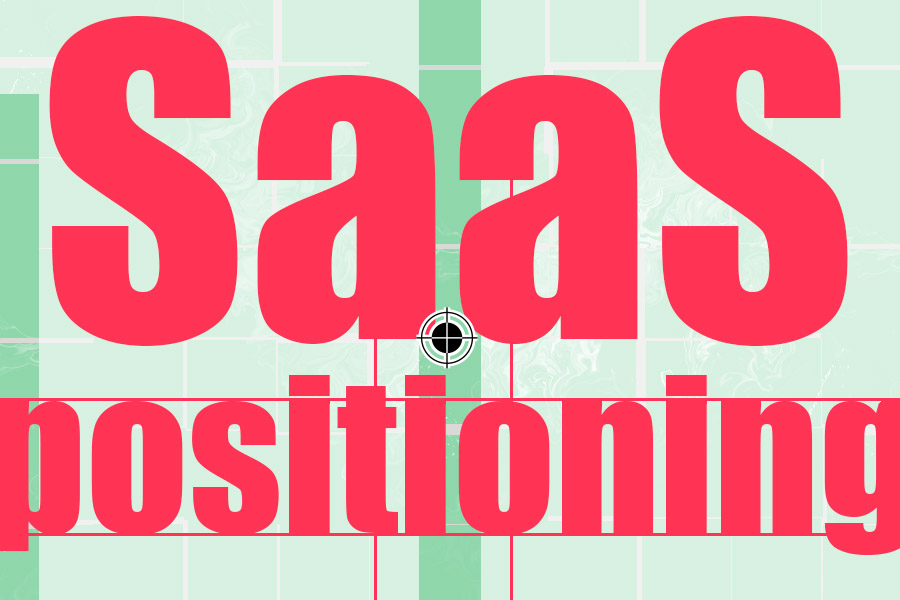
Positioning a SaaS Product
SaaS businesses often fail to describe who their product is for or indeed how their product helps their target end-user, or even what value their product brings to their target customers’ organisation.
Positioning is everything. Get it right and it becomes so much easier to build content and campaigns which move your target users into trialling and purchasing your product. Good positioning exercises serve to answer the most important questions and give you a platform for the successful marketing of your product. So here are five things to consider when positioning your SaaS product..
1. The Competition
By studying the competition in whatever software category your product sits, you can quickly establish whether or not your competitors have worked out the answers to the big questions. By studying your competitors marketing output you can obtain insight into how they have decided to position their product.
If the majority of your competitors are addressing similar pain points within their messaging, then perhaps they have understood what triggers interest within your product category. Perhaps your competitors' products are aimed at solving a set of business problems, or describe their value in a certain way. Of course your actual product needs to stack up against the competition, but remember unless you can claim why your product is uniquely qualified to be a leader then you are probably falling short. This may mean changing how you think about the sector in which your product sits. Perhaps your product can be differentiated by its suitability for certain sub-sectors or industries. The more suitable and targeted and relevant your product becomes, the easier it is to make claims and of course back up those claims with case studies.
It is always better for your product to be perceived as a leader in a smaller category than an also-ran in a race in which it will struggle to compete. Fact.
2. Your Current Customers
Not all SaaS products are made equal, but knowing where your advantages lie (and where they don’t) helps you to position inside a particular category with confidence.
Within your marketing you will be describing product features using words, images, stylised screenshots and video etc. Sometimes (but very rarely) features alone sell products, and it’s often ‘killer’ features which are heralded as driving interest among those early adopters - those people who ideally end up evangelising on your behalf.
However in SaaS, features alone definitely do not sell product. You need to understand why customers might use your product in order to understand what value you're providing. And that means doing research.
Assuming you already have some customers, the place to begin is by surveying them. You can obtain amazing insights from talking to your own customers - insights which will help you describe the value of your product to your future customers! There are lots of ways to do this. Done successfully, surveying will strengthen the existing relationship between your customer and your product, while providing you invaluable data. Online surveys can be designed to solicit detailed responses which build an entire picture of how your SaaS product is used and perceived. This information is gold if used correctly by your marketing team.
3. Positioning against ‘the problem’
Your product should be positioned to solve identified problems or meet specific challenges. Understanding your target customers' challenges is another way to work out how to describe what value your product provides.
It’s surprising how many SaaS products are developed only because they can be! If you haven’t identified why your well-defined set of customers should care about your product, then you haven’t a chance of marketing it very well.
Alternatively if you product is ‘positioned against a problem’ then the marketing challenge becomes simpler. Your challenge then becomes how to reach those who have the problem, before driving digital journeys which persuade them to trial your product.
Of course, you’ll need a deep understanding of ‘the problem’ from both the target-user's perspective and also how it might manifest inside their organisation. Again the answer to this is research.
4. Wide V Tight
It is common for B2B SaaS marketers to begin with a wider position and then tighten as they get more data to support the case for doing so.
For example, a DAM (Digital Asset Management) platform can be used in my ways and by many types of end user. It’s possible to market a DAM without defining exactly who it is for and what benefits it provides, although without any context it would be a struggle. So as soon as you have a handle on who is getting value from your product and exactly how they’re using it, you will want to tighten your positioning. Why? Well generally you want to make your marketing and messaging more pointed and pertinent to specific users and use cases. Relevancy drives engagement.
For example you may decide to position your DAM so that it is aimed at users suffering a specific set of workflow challenges, or perhaps aim it an industry segment, e.g. the Food & Beverage sector. In either case your audience becomes smaller, your marketing more targeted and your case studies more relevant.
The benefits of having tighter positioning are many. Clearly as your content and campaigns become more targeted, the costs of customer acquisition rapidly comes down, and your marketing becomes more efficient.
5. The User
Marketing B2B SaaS differs depending on whether your product is for enterprise or SMEs. For enterprise, the lead times are longer and obviously you have a lot more people to persuade. These people might be marketers, analysts, technologists and ultimately the C-Suite.
For non-enterprise products the trend is very much more towards marketing at the end user, and persuading them to trial a product and turning them into a champion, before arming them with what they need internally in order to persuade the eventual stakeholder to purchase.
If this is your strategy (and it's a good one) then the majority of your marketing should be aimed at understanding the problems and challenges faced by your target end user. In a nutshell, your task is to see the world through their eyes, and describe how your product makes their world better...
…
The author Dave Brewis conducts Positioning exercises and can be found here at TEN80
“Ultimately positioning is an art. Positioning exercises begin with listening and end up defining exactly how your product is uniquely qualified to be a leader. Be prepared to drop some of the preconceptions and assumptions you have around your product and its uses! Positioning involves working out exactly what value your product delivers to a well defined set of customers who actually care. A solid positioning exercise provides a platform on which to build messaging, content and campaigns. Without this much of your marketing will be guesswork, and your budget deployed on a trial and error basis.”
Posted on May 26, 2021


